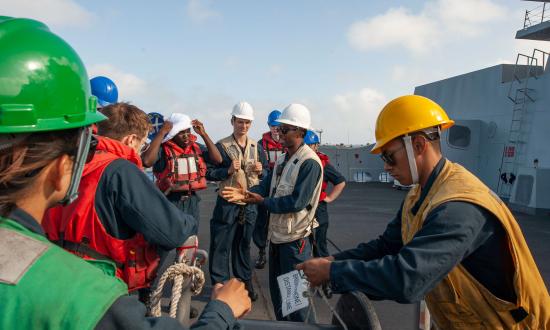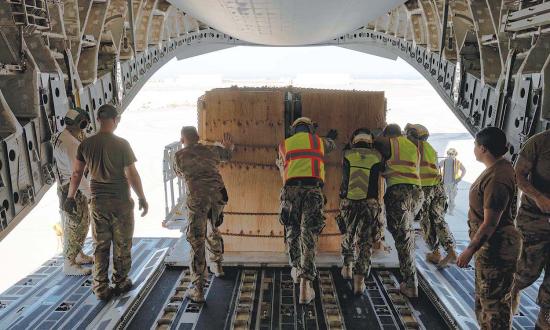Command is an awesome responsibility at any pay grade. The merits of junior command are well-recognized if sometimes disputed. What is indisputable is that today’s military is a zero-defect world in which mistakes often are unforgivable, and there are no do-overs. For a junior officer in command, this can be magnified. My experience in junior command taught me that one might ease the burden and create conditions for success by communicating, building up your accounts, being able to say no, and having fun.
Communicate By All Means
Communication is crucial in any relationship, but especially so for a junior commanding officer managing a relationship with an operational command. In the Coast Guard, the operational command of so-called patrol boats often is a sector. A curiosity of Coast Guard sectors is that, unlike a U.S. Navy oversight model, the chain of command tasked with overseeing Coast Guard patrol boat operations may have little to no background in life at sea and limited knowledge of shipboard norms. This is because Coast Guard sectors are responsible for carrying out diverse missions and include many types of units, from small-boat stations to aids-to-navigation teams.
This puts young commanding officers in positions in which, despite their inexperience, they must be subject-matter experts on the operations they are tasked to carry out. Accordingly, junior commanding officers need to communicate early and often with their chain of command. Forward leaning, measured communication is the bedrock of success for managing this relationship, as junior officers build trust and confidence with their command.
Face-to-face communications are an excellent way to do business and should be prioritized. Circumstances such as COVID-19 or geographic distance, however, often preclude junior commanding officers from regularly meeting with their superiors in person. To be successful, junior commanding officers must become masters of electronic communication.
I found monthly updates in the form of an e-newsletter to be an easy way to communicate the needs of my command to stakeholders, provide updates on inspections and visits, laud the efforts of partners and maintainers, and boast the accomplishments of the crew. Much has been written about the pitfalls of leadership via email. Nevertheless, timely email updates have multiple benefits. For example, in the case of a machine casualty, they can show you are engaged and actively seeking a solution to the casualty, and they also establish a timeline of the event or casualty in question. A template for briefing issues via email is a simple recipe for success:
1. What the issue is (a basic, non-jargon version of the problem).
2. What the way forward is (What is your plan? Are you waiting for parts? When will they arrive?).
3. When you will have your next update (establishes a baseline expectation and does not leave people wondering).
Build Up Your Accounts
The phrase “it’s not a matter of if something will go wrong, but when” definitely applies to a tour as a commanding officer. With the wide scope of responsibilities that comes with running a unit, there are myriad “things” that can go wrong, from personnel, to machinery casualties, to mishaps. Instead of hoping and trusting all will run smoothly, a practical approach is to prepare for the worst-case scenario by preemptively shoring up the various aspects of running your command. I call this “building up your accounts.”
A cynical view is that you should do all of these things anyway. Realistically, however, there are significant demands placed on cutter crews. This method is useful to ensure all areas receive due attention.
Practically speaking, building up your accounts starts with a blank sheet of paper. You write down every aspect of running your command and potential pitfalls. For instance, do not just write “personnel.” Under the banner of personnel, write sexual assault, performance and discipline, discrimination and harassment, diversity and inclusion, and so on. Then, develop corresponding solutions. Take sexual assault, for example. Take regular opportunities to socialize sexual assault reporting methods, including in the Plan of the Day, qualification boards, and through displays in prominent thoroughfares. Under discrimination, you might take advantage of cultural heritage months to celebrate diversity and inclusion in the Plan of the Day, or commit to cultural heritage events, such as hosting a culturally significant meal. This commitment is not only the right thing to do, but it also reinforces servicewide diversity and inclusion plans and, most important, emphasizes that discrimination has no place in your command.
This method is applicable not only for administrative “accounts,” but operational ones as well. Forehandedness in the operational sphere goes a long way toward preventing mishaps and facilitates proficiency at every level. Simple examples abound, such as regularly holding underway officer-of-the-deck roundtables to discuss mishap case studies, standing orders, or to emphasize sound watchstanding principles. Similarly, fostering a training culture ensures your crew is ready to meet any challenge. Incorporating training into the regular in-port battle rhythm is a simple way to ensure proficiency and allows a crew to build up to increasingly complex (and
realistic) training scenarios.
Overall, building up your accounts should not be viewed from the perspective that it will “save” junior commanding officers when they land themselves in hot water. Instead, it should be appreciated as a useful framework that helps junior officers parse all the minutiae associated with running a ship and ensure they receive appropriate attention.
Be Able to Say No
Intertwined with communication, one of the most challenging lessons a junior commanding officer must learn is how to say no. As a rule, junior officers selected for early command are highly competent and eager to please. When mixed with a chain of command that might not fully understand the intricacies and hardships of shipboard life, there is the potential for junior officers to be faced with the uncomfortable prospect of telling a senior officer “no.”
In the high-stakes domains in which the Coast Guard operates, however, “no” could mean a gap in vital search-and-rescue coverage or neglecting a high-visibility presidential security mission. Accordingly, tact, decorum, and a risk- and policy-based approach help ground potentially uncomfortable conversations. A template for briefing these types of scenarios could look something like:
1. Acknowledge the “why” up front and proceed to explain it. My team and I cannot complete this mission because X. For example, X piece of equipment is degraded, the weather is doing X, etc.
2. This means Y. I cannot accurately know the depth of water I am in, I cannot launch my small boat, etc.
3. Because of Z policy. This keeps the conversation grounded in fact and communicates you have done your homework.
4. The risk implications of this are A compared with a gain of B. The Coast Guard operates on a codified risk versus gain continuum. However, for its sister services, highlighting the risk versus gain of a potential operation can be an excellent framework for assessing the need to execute an operation or mission.
5. My recommendation/intention is C. Often, offering an alternative solution or compromise that is amenable to risk and policy constraints while remaining forward leaning is more likely to be met with enthusiasm than “I cannot do it!”
This diplomatic approach accomplishes several things for a junior commanding officer. First, it helps organize and streamline thoughts into a digestible and cogent brief. Second, it keeps the discussion grounded in policy and reasoning, instead of emotion and bluster, which is important for two reasons: 1) It demonstrates you have “done your homework” and bespeaks confidence; and 2) It prevents emotions from bleeding into decision-making, which often can happen in stressful and high-consequence environments.
In short, it is not a matter of if, but when a junior commanding officer will need to tell the operational commander no, and he or she needs to be prepared for it. This template ensures a crisp, professional exchange, which allows the operational commander to make a decision armed with all the facts and associated policy.
Have Fun
In the modern Coast Guard, a number of requirements are placed on individual units. In addition to operations, a deluge of inspections and administrative requirements are normal for even the smallest unit. Results-oriented junior officers selected for junior command are apt to begin writing a to-do list paired with a color-coded calendar at the mention of inspections and suspense dates. This bias for action is laudable; however, as a commanding officer, there are other responsibilities to tend to besides operations and inspections. It is your job to balance competing priorities against the service’s future needs.
In a time when the Coast Guard is offering $40,000 bonuses to attract midgrade afloat officers and afloat enlisted billets are constantly resolicited, there is an urgent need to cultivate future generations of seagoing personnel at all levels. Junior commanding officers—despite the crush of external requirements—must help junior personnel see the joy in going to sea. In the hierarchy of demand signals, operations will always rise to the top, but things such as swim calls, fishing calls, and advocating for unique and foreign port calls can reap enormous dividends toward the service’s future health. Encouraging underway traditions and celebrating milestone events, such as earning a cutterman pin, or participating in professional organizations such as the Navy League/Cutterman Association establish a professional baseline that can be emulated.
It is important to remember that today’s nonrates and third-class petty officers are tomorrow’s engineer petty officers and executive petty officers. Senior officers can encourage and mentor effectively. Junior commanding officers, however, are closer in age to the average crew member and enjoy a unique opportunity to mentor and encourage junior enlisted personnel up close, every day. Fostering and maintaining an environment that is fun and rewarding will ensure a robust pool of seagoing Coast Guardsmen, which will build a strong foundation for the future success of the service.
Early command is an unparalleled crucible for preparing junior officers in the Sea Services for greater responsibilities. In an increasingly dynamic maritime security environment, the Coast Guard is being called on like never before, and it needs the very best commanding officers in the senior ranks. To navigate the challenges of their first command at sea and pave the way for future command success, junior officers must learn to communicate actively, build up their accounts, be able to say no, and endeavor to have fun.







